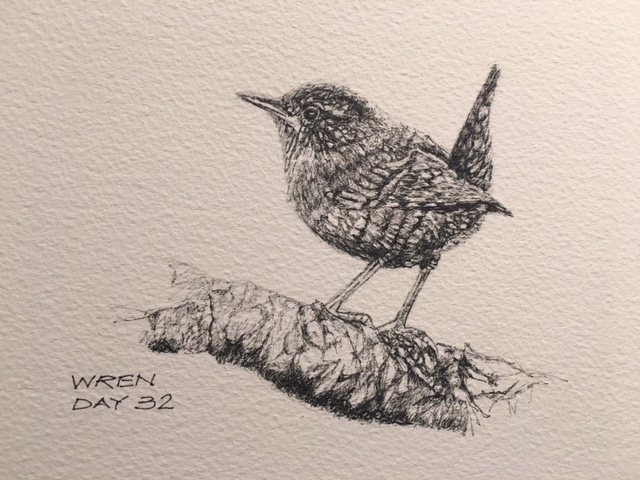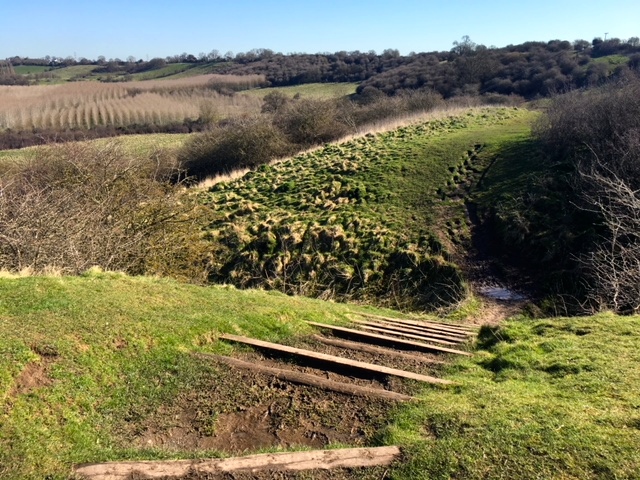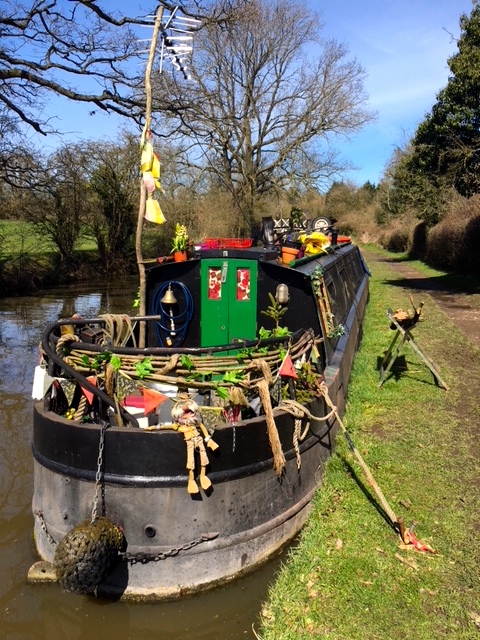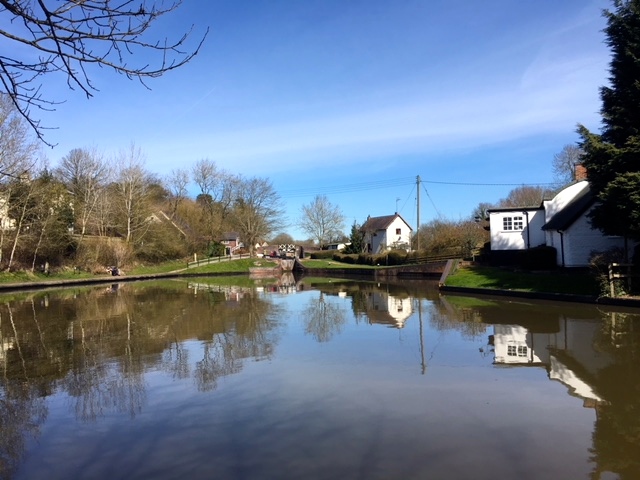From: Henley-in-Arden to Meriden
Distance: 10m / 16km
Cumulated distance: 412m / 663km
Percentage completed: 40.09

Glorious sunshine woke me and stayed with me nearly all day today. It even looked to be drying up some of the mud .. well, almost. I was able to join the Heart of England Way almost from the door of the pub in Henley in Arden. The town’s name refers to the Forest of Arden, which sadly no longer exists but did make a guest appearance in Shakespeare’s ‘As You Like It’. Back in the middle ages, the mead bottle would have been cracked open if the King gave a town permission to hold a market or fair. Such was the case with Henley in Arden and the town grew prosperous as a result. The town had another claim to fame: it was known for its archers .. no! not the Borsetshire Archers, but mean, lean long-bow archers. Henley’s archers are known to have fought at Evesham in 1265, at Bannockburn in 1314 (where the Lord of the Manor, John de Montfort, was killed), at Crecy in 1346 and probably at Agincourt in 1415. Six hundred years later, Henley is still the place to go if you want to become an archer. You can pick and choose between all sorts of archery courses and visit the Archery Shop to arm yourself to the teeth with all manner of bows and arrows.
Before the Battle of Agincourt in 1415, the French, anticipating victory over the English, proposed to cut off the middle finger of all captured English soldiers. Without the middle finger it would be impossible to draw the renowned English longbow and therefore render the archers incapable of fighting in the future. This famous weapon was made of the native English Yew tree, and the act of drawing the longbow was known as “plucking the yew” (or “pluck yew”). Much to the bewilderment of the French, the English won the battle and began mocking the French by waving their middle fingers at the defeated French, saying, “See, we can still pluck yew!”

Battle of Agincourt
Today, Henley is a thriving market town with a mix of cultures, yet remaining quaint.

The main street

Mix of old and the exotic new

Lingering Easter
The Civil War also had a serious impact on Henley. The town sits at a busy crossroads and both Parliamentarians and Cavaliers passed through, pillaging and looting as they went. Poor old John Milward had no sooner replaced all his bedding, pewter and brassware in 1642 after Charlie’s boys had helped themselves, than the Roundheads came through in 1643 and did just the same, leaving him destitute.
The day felt very quiet as I walked across the countryside without Swampy and Nigel. No-one to ask me what sort of business I had, no-one to banter with and no-one to share a new-found advantage of mud with. It had been great having them with me .. talking about everything from fears of eternity to how far it was to Batsford.
Quick aside .. mostly for Swampy:
‘I have a business’
‘What is your business?’
‘It’s an airline company’
‘And how’s that going for you?’
‘It’s really taking off’
Just 400 metres from Henley is the site of the motte and bailey Beaudesert Castle. It was built in the 13th century after the Norman Conquest, on the site of an even earlier castle. All that remains is a single stone. From the top of the mound there were terrific views which extended for miles.

Steps up to the castle site
Yesterday, we’d seen honey coloured stone being gradually replaced by red brick, timber frames and a lot of thatched roofs. Today there was no sign of the stone as I got into the heart of Warwickshire.

Warwickshire farmhouse
Not long into the journey I joined the towpath of Stratford Canal. I LOVE canals .. not only for their flatness, after a lot of hill climbing but also for the way that there’s always something going on and that they are big attractors of birdlife. I had a coffee at the delightful Fleur de Lys pub, which sits at the side of the canal. Everyone was very chatty and SANE’s coffers ended up being nicely swelled. www.thefleur.co.uk

The welcoming Fleur de Lys

Barge passing through

The Jolly Rotten

Basin where the Stratford and Grand Union canals meet
I set off today to skirt around the UK’s second city, Birmingham. The journey’s end would be Meriden, notionally the middle of England. Not the middle of my journey, however. I will only reach that exciting, fizz-drinking moment in a fortnight when I tackle the Pennines. Nevertheless, it was the carrot which kept up my pace today.

Pussy willows
The hedgerow felt as if it were on the verge of bursting into spring. It was hugely uplifting, despite the continuing mud. It wasn’t long before I passed between two rather splendid stately homes: Packwood House and Baddersley Clinton. Both are National Trust properties and both have fascinating histories. Packwood is a timber framed manor house, which was bought in the 1920s by Graham Baron Ash who lavished money and time on furnishing the place with Tudor stuff. But it was the garden that intrigued me. It’s famous for its yew trees (lots of archers round here), which are clipped to represent the Sermon on the Mount, complete with the four evangelists and the 12 apostles. There is a large yew which tops the mount, presumably Jesus and also a mass of much smaller trees to represent the multitude listening attentively to the sermon. They were planted in 1650. Sadly I couldn’t see them without going into the property, so you’ll have to take my word for it .. or even better, visit!
Baddersley Clinton, which I could see from the Heart of England Way, is a moated manor house dating back to the 13th century and while Packwood kept its Christians in the garden, Baddersley Clinton was a place where persecuted Catholics sought refuge in the 16th century. We once lived in a Tudor cottage in Surrey, which had a bookcase which concealed a secret door to a secret staircase and a secret room. It was a fantastic room for confusing guests with a disappearing party trick.

Countryside around Baddersly Clinton

Fields of Warwickshire
I crossed numerous fields of newly emerging crops today. For the first time I listened to one of my podcasts. Given the countryside could so easily have been Borsetshire, I settled on the last Omnibus of The Archers. I became so engrossed in their world that I half expected to see Eddie Grundy standing at one of the many stiles I crossed.

Goose House
When I was planning my route it was difficult to know which way round Birmingham to walk. I eventually decided on the east, as it meant I could visit Meriden, the centre of England. The village sits in a green corridor called the ‘Meriden Gap’, between the conurbations of Birmingham and Coventry. A medieval stone cross on the village green alerts visitors to their middling location. Also on the green is the National Cyclists’ Memorial, which commemorates all cyclists who gave their lives in both World Wars. It was placed in Meriden so that it would be easier for cyclists from any part of the country to reach it.

Reaching the middle of England
Not too surprisingly, given the preponderance of yews in the area, Meriden is home to reputedly the oldest archery club in England. It was established at a meeting at the pub in 1785, many years after the middle finger gesture had become a well-used silent insult. Even for screen savers, Nigel!
It was a long day (I don’t have the technological know-how about how to change the mileage from 10 to 15 miles) but it was hugely enjoyable as well, even without the companionable Swampy.

End of day as I reached Meriden
Black Dog Tails
Fancy lobster for dinner? OK, so Lila isn’t really a hero black dog but in my book she goes a long way towards it. Her owner has trained her to dive for lobster! You can see her in action if you follow the link.
![]()




Good choice of podcast given that you are in Henley in Arden! And fancy saying “Pluck Yew!” to The French… I assume that part of England voted for Brexit??
Wow .. didn’t know you were an Archers fan too!! x
Good to hear you’ve got some decent weather at last – you’ve earned it.
Have you noticed the changing of accents as you progress? On a long walk I find I detect the gradual change from one to another.
If you want to pass a bit of nerdish time Google “centre of Britain/England/UK, and/or “furthest from sea in..”.
There is a lot of pseudo academic stuff there debating what parameters should be used etc.
I too find canals fascinating. The iconic boats on the canal are usually referred as narrow-boats and definitely not long-boats – they were for Vikings.
Thanks for the narrow-boat tip .. hope you saw I’d included the correct word in yesterday’s blog! I have definitely noted the accent change .. the vowels around here are definitely flatter than a few days ago in Gloucestershire! I’ll save the nerd time till I finish!
I can’t believe you’re covering so much ground so quickly, Jules! Middle of England already! Well done you! Xx
As we can head due North all the time, the ground is disappearing beneath our feet!! Thanks so much for your message. xx
Sounds as though the past few days have been cheery with good progress. You are now following paths that are familiar to me. It is amazing, that when viewed over the gentle plod of one’s feet, the memory stays clear for years and years. Keep up the good walking Jules, you are going really well . xx
I suspect the muscle memory helps. I’m sure your memoir of the journey helped enormously, Marilyn. As I was writing about walking to Lichfield I remembered you remarking on walking in the footsteps of those made by people for centuries. xx
Omg Jules 40% done!! And in the worst under foot mud – you are a star! Wishing you dry sunny days ahead xx
Thank you, Kate. Forgive me if I’ve said this before but your son was an absolute darling .. great great chat, no complaints when I took him to Batsford instead of Blockley, a lorra laffs AND he carried my pack!! Love him to bits. x
Hi Jules – we are just loving your amazing blog. You have done so well – 40% and counting!! You are inspiring and I think Alon and I need take some inspiration from you and plan an adventure.
Anne, you have always been the inspiration for me .. all your fell running, cycling and cracking the ice to swim in the Hampstead Ponds! xx
Hi Jules.. wow.. 40% of the way! We have really been enjoying your adventure, albeit vicariously.. you are doing an amazing job, would love to be with you carrying your pack for a day or so. Soak it all up for those us couch dwellers.. love love love your work.. Robyn
Lovely hearing from you, Robyn and I would love love love to have you by my side, not just for the pack-carrying!! xx
Hah, I shall never wave that middle finger again without muttering a suitable “pluck yew” under my breath in acknowledgement of the origins of the custom. Thanks for that memorable historical tit-bit, Jules
Glad to oblige! It is a fascinating country ..
From here this is going to be so exciting and interesting Jules – out of the familiar and into new territory and info! Loving the yew trees and bows and all accompanying hand signals! Got to love a black and white Tudor house though… xx
Does that mean you never got further north than the Watford Gap, Frannie?! Loving your messages. Thank you so much. xx
The barge reminded me of “Rosie and Jim” that rather creepy young childrens programme with a man and 2 rag Dolls going up and down the river! Your blog is so informative Jules we are all learning a lot about England, I did not know exactly where the middle was so thats todays new fact! So glad the weather has improved for you…it could have got any worse!! xx
Gosh, yes, that’s a blast from the past. Glad you’re enjoying the blog .. I do love writing it. But please apologise to Adam for me not getting back to his lovely email. The day’s just aren’t long enough! x
It was lovely to meet you, thanks for stopping by! Good luck for the onward journey.
Emma
Thank you lovely Emma at the Fleur de Lys!